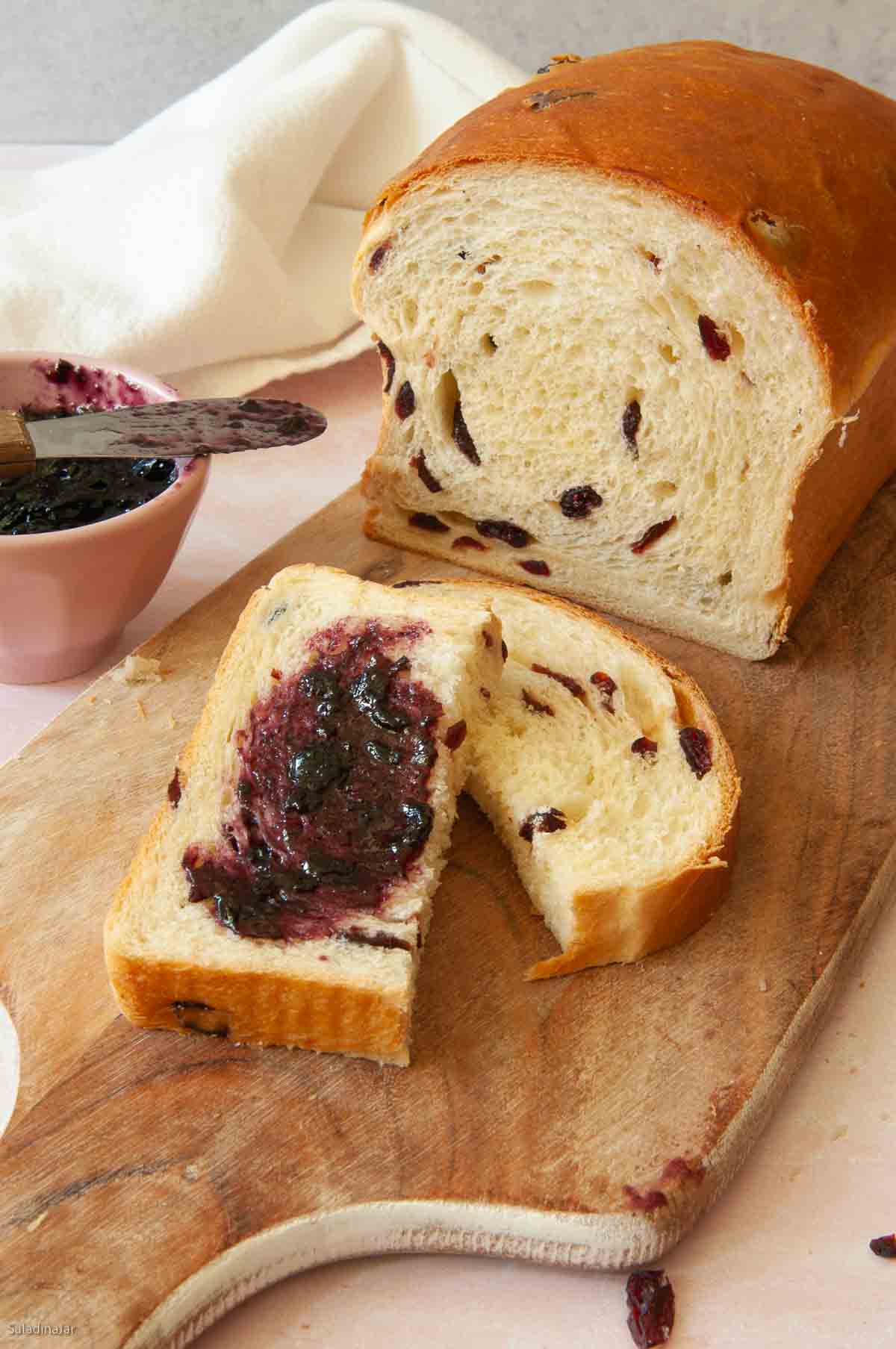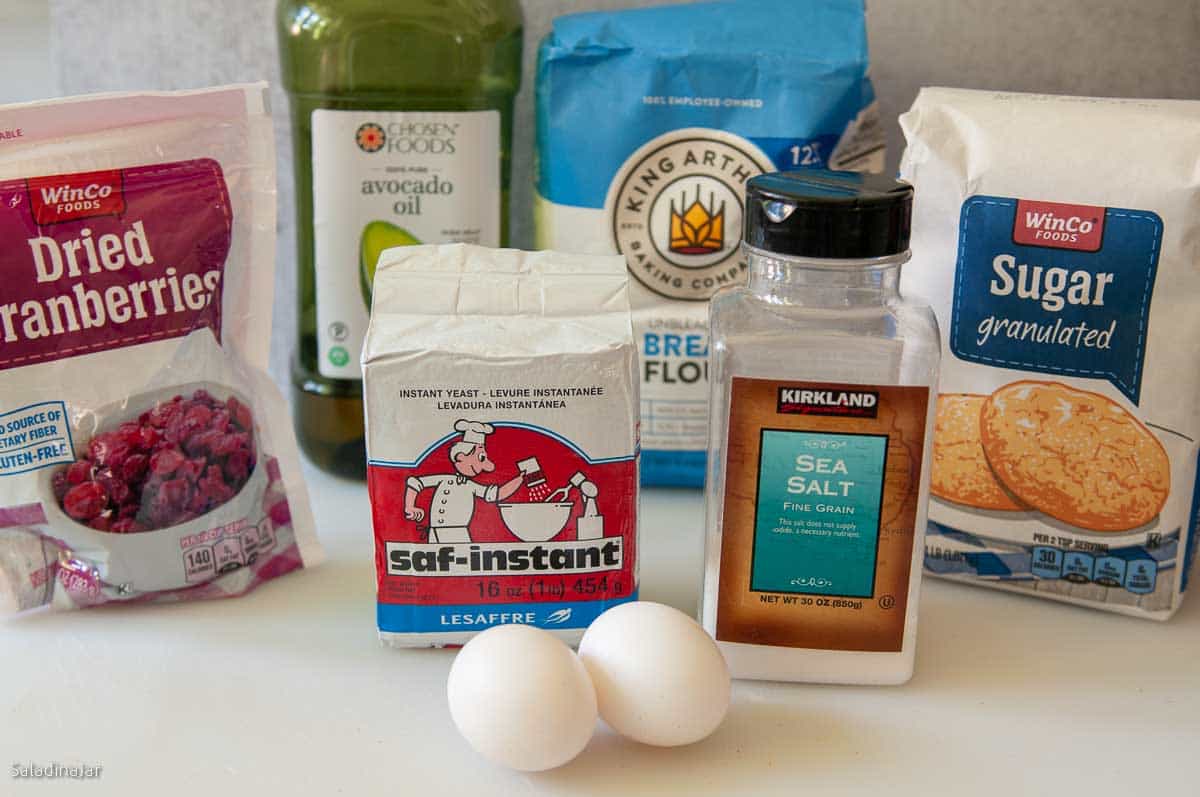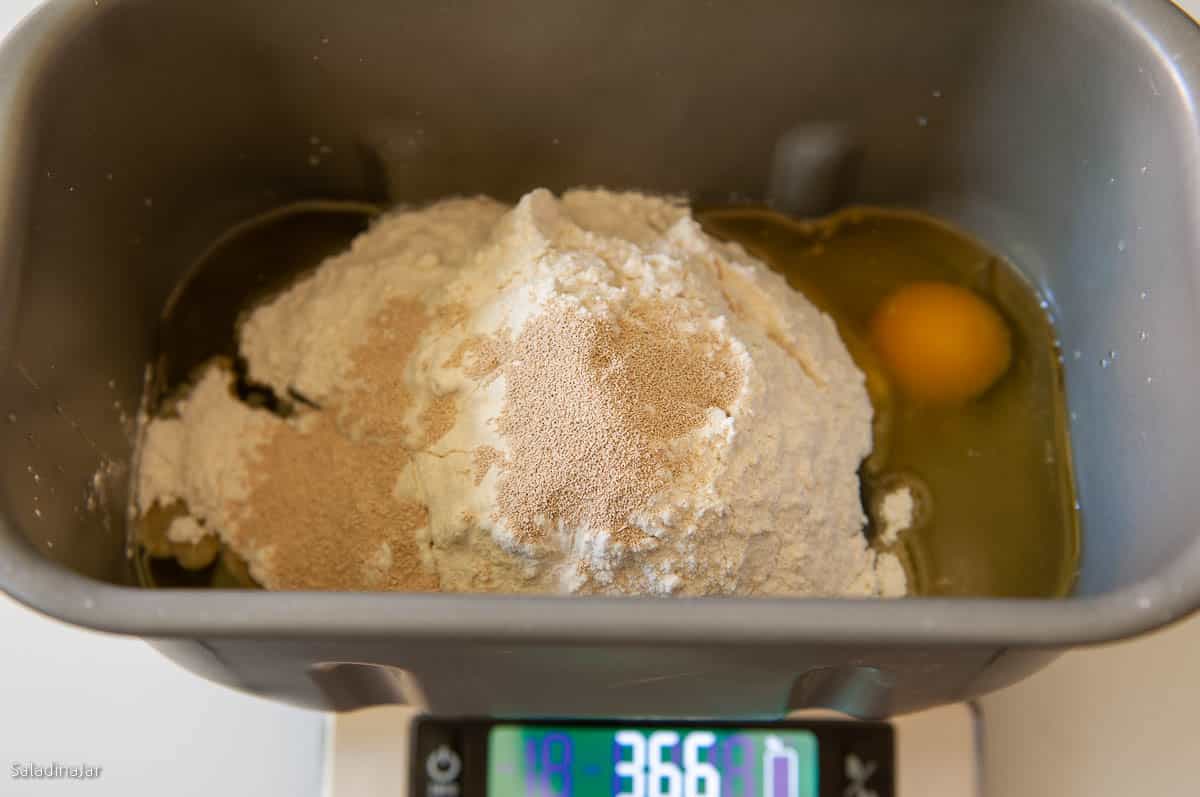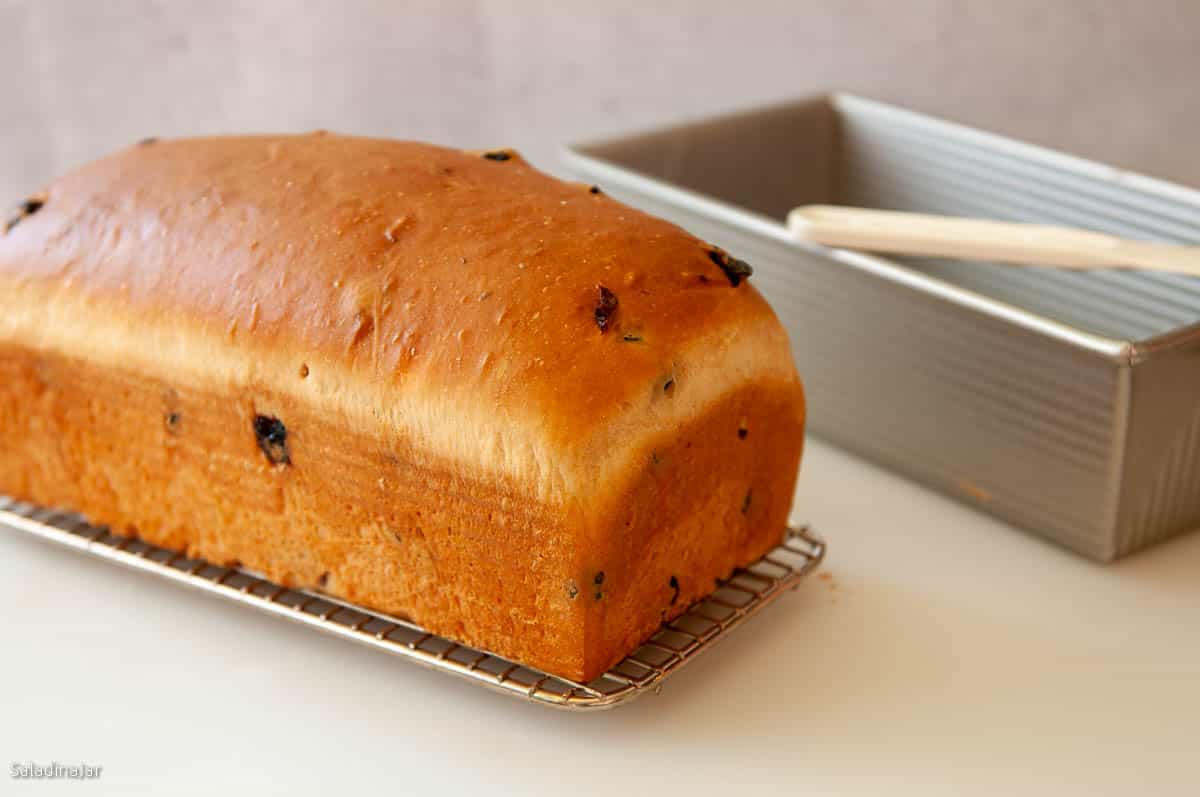Bread Machine Fruit Bread: A Kiss of Sweetness To Start Your Day
Sneak Preview: This Bread Machine Fruit Bread with dried fruit is a great way to start your day. Mix and knead this recipe in a bread machine, then shape and bake it in your oven. This bread works well for breakfast toast, bread pudding, or French toast. The golden color is a sign of the richness provided by eggs. Bonus: It’s dairy-free.

As an Amazon Associate, I earn from qualifying purchases.
Are you looking for a soft, sweet, and eggy bread recipe for chicken salad, ham salad, or turkey panini sandwiches? Or maybe you need bread for toast and jelly in the morning or for making French toast. How about a memorable peanut butter and jelly sandwich for lunch?
Five Reasons Why You Will Enjoy This Fruit Bread Recipe
- This bread machine fruit bread recipe is excellent for eating out of hand, especially on the first day.
- It is not a chewy or rustic style bread but soft and somewhat sweet with a tender crumb.
- Easy to customize–use your favorite dried fruit.
- Bread flour helps keep it from falling apart in addition to shaping by hand, even when you use a breadmaker.
- If preferred, mix this bread with an electric mixer or by hand. See the recipe notes for details.
Happy Bakers Speak Up
“I made this bread yesterday and LOVED it! Thanks for putting this recipe up!” — WENDY


Ingredients and Substitutions
- WATER: I like to use de-chlorinated water (let it sit on the counter for 24 hours) or spring water. For most people, tap water will work fine. If you want richer bread, substitute milk for water. (No need for warm water as the heat produced by the bread maker paddles will heat the ingredients in a hurry.)
- EGGS: Size is important when it comes to eggs and bread dough. Eggs count as a liquid. The more liquid you use, the more flour you need. I always use large eggs when developing my recipes. If you want to use a different size, adjust the total liquid in this recipe accordingly. For example, when using extra large eggs, use less water.
- OIL: I like to use olive oil for two reasons. It has health benefits and adds a fruity flavor that complements the dried fruit. Butter is an excellent alternative to oil if you don’t mind dairy products. No need to melt it. Instead, chop it finely, and it will soften quickly once the kneading begins.
- SUGAR: I use granulated sugar. If you want sweeter bread, add another tablespoon of sugar. If you want to, cut out the sugar completely, but the dough will take longer to rise. Substitute brown sugar or honey if you prefer. If you use honey, the moisture level of the dough may be affected. Check the dough as it kneads in the machine in case it needs correction.
- SALT: This recipe was tested with table or sea salt. If you want to use Kosher salt, add at least ¼ teaspoon of extra salt. You can reduce the salt, but please don’t cut it out completely. Yeast needs salt to behave correctly. No salt often results in the dough rising too fast, then falling when you put the shaped loaf into the oven to bake.
- FLOUR: I like bread flour in this recipe. It makes a sturdier sandwich loaf and supports the dried fruit. If you try substituting all-purpose flour, you may or may not need to add Vital Wheat Gluten to help the bread rise. (Follow the directions on the package for the amount.)
- YEAST: I recommend using instant yeast or bread machine yeast for every recipe you make with a bread machine. See the recipe notes if you want to use active dry yeast.
- DRIED FRUIT: You could make this bread without it, but dried fruit takes it from the blue ribbon category to grand champion-purple-ribbon status. Below, you can see it with dried cranberries. In the top picture, I used dried cherries. Try raisins, currants, dates, dried blueberries, or mixed dried fruits.
If you like fruity flavors in bread, don’t miss these recipes for Orange Sweet Rolls with Cream Cheese Icing, Artisan Rosemary Yeast Bread with Dried Cranberries and Pecans, or Fresh Blueberry Yeast Bread from a Bread Machine.
📌Bread Maker Tip📌
Adding fruit (or nuts) at the end of the kneading process preserves the fruit’s integrity. Many bread machines have a unique signal to tell you when to add fragile ingredients.
How To Mix and Knead Bread Machine Fruit Bread



Look for the dough to stick to the sides, then pull away cleanly. The dough should be shiny and elastic. If it doesn’t stick at all, add liquid one tablespoon at a time. Allow the dough to absorb the moisture before deciding whether to add more.
If the dough is too sticky and won’t pull away cleanly, add flour 1 tablespoon at a time, allowing the dough to absorb the flour before adding more.
Add the dried fruit in the last 5 minutes of kneading. You can add them earlier, but the paddles may pulverize the fruit. If you forget to add the fruit, you can always add it manually as you shape the dough after the DOUGH cycle is complete.

Egg Bread with Dried Fruit from the Bread Maker Pan to the Oven

I like to use a silicone baking mat because you pick up the whole mess, shake it out in the trash or sink, and throw it into the dishwasher or give it a quick swish through soapy water.










Frequently Asked Questions About This Bread Machine Fruit Bread Recipe
You can, but the egg and sugar in the recipe will give you a golden-brown finish without a glaze. If you want to add a wash, brush the rolls with one egg yolk combined with one tablespoon of water and a pinch of salt.
They are all similar in that they use several eggs, resulting in a soft and tender texture with a yellow color.
Brioche is famous for containing lots of butter (more than double the fat in this recipe) and multiple eggs. Most instructions call for refrigerating the sticky dough, so it will be easier to shape. Challah is similar to this egg bread recipe, often dairy-free, and traditionally presented in a braided shape. All three of these bread recipes can be successfully mixed and kneaded in a bread machine, then baked in a conventional oven.
Yes. Since this bread will only stay fresh for a few days, double wrap it and store it in the freezer. Use within 3-4 weeks.
This recipe was adapted from the book, “One Hundred Years of Bread”(paid link) by Sidney Brockman Carlisle.
Help at Your Fingertips: For questions or suggestions, email Paula at saladinajar.com. If you need help, I’m happy to troubleshoot via email (faster than leaving a comment). Attach pictures and as many details as possible for the best advice.

Bread Maker Fruit Bread Recipe
Rate this recipe
(5 stars if you loved it)
Video
Ingredients
- ⅔ cup (151 g) water
- 2 large (100 g) eggs
- ⅓ cup (72 g) vegetable oil (I prefer olive oil)
- 3 tablespoons (36 g) granulated sugar
- 1¼ teaspoons table or sea salt
- 3⅓ to 3½ cups (400 g) unbleached bread flour (Start with 3⅓ cups of flour and add more if necessary.)
- 2 teaspoons instant or bread machine yeast
- ¾ cup (91 g) dried cranberries, dried cherries, dried apricots, chopped dates, raisins, or a combination
Instructions
- Place ⅔ cup (151 g) water, 2 large (100 g) eggs, ⅓ cup (72 g) vegetable oil, 3 tablespoons (36 g) granulated sugar, 1¼ teaspoons table or sea salt, 3⅓ to 3½ cups (400 g) unbleached bread flour, and 2 teaspoons instant or bread machine yeast in the bread machine pan in the order listed. Select the DOUGH cycle and press START.
- Add ¾ cup (91 g) dried cranberries, dried cherries, dried apricots, chopped dates, raisins, or a combination when the add-in beep signals or about 5 minutes before the kneading phase ends. (Check your manual for the specific timing of your model.)
- Recheck 15 minutes into the DOUGH cycle to assess the consistency and moisture content of the dough. The dough should stick to the side, then pull away cleanly.If your dough is too wet, add flour one tablespoon at a time, giving the dough a chance to absorb the flour between each addition.Conversely, if the dough is too dry, add one tablespoon of liquid at a time until the dough looks just right. Read more about this surprising secret to success with a bread machine here.
- When the DOUGH cycle is finished, check the dough to see if it has doubled in size. If so, remove it from the pan to a floured surface. If not, leave it in the bread maker pan until it doubles before proceeding. (This may happen when your kitchen is cold in the winter.)Remove the dough from the bread maker onto a lightly floured surface.
Shaping the dough:
- Knead the dough slightly to press the air out of the dough. Press with your hands or use a rolling pin to shape the dough into a rectangle, with the shortest side slightly longer than your pan.
- Starting with the short side nearest you, use your hands to roll the dough into a cylinder shape. Tuck ends under and carefully place the roll into a loaf pan (10 x 5-inches or 9 x 5-inches). It should fill the pan about halfway.
- Cover the shaped loaf loosely with a clean towel and allow it to rise in a warm place until almost double. This rise may take as long as an hour or more, but don’t watch the clock. The dough appearance is your only true guide.
- Preheat your oven to 350˚F (180˚C).
- Bake until cooked through, and the crust is golden brown–approximately 45 minutes. Cover with aluminum foil during the last third of the cooking time if necessary to protect the loaf from over-browning. When the loaf is done, the internal temperature should reach 190˚F (88˚C). Check with a quick-read digital thermometer.
- Let the baked loaf cool in the pan on the counter for 15 minutes. Turn out onto a cooling rack. Allow the bread to cool completely before slicing, or you risk squashing it as you slice. (Sometimes, eating warm bread is worth the risk of crushing it. 🤔)
Notes
- To make this recipe in a heavy-duty stand mixer: Add ingredients to the bowl in the same order. Turn on LOW to mix until all ingredients are moistened. Then, using a dough hook, turn up the speed to 2 or 3. Continue beating/kneading until the dough becomes smooth and elastic (about 5-10 minutes). Cover and allow to rise in a warm place. Deflate dough gently and shape as indicated in the recipe.
- If making by hand: Combine all ingredients into a shaggy ball in a large bowl. Turn dough out onto a floured surface. Knead with your hands until the dough becomes smooth and elastic. Kneading will likely take 10-20 minutes, depending on your experience. Place the dough ball into a greased bowl. Cover and allow to rise until double. Deflate the dough gently and shape it as indicated in the recipe.
- Please note: If you only have active dry yeast, use 1/4 teaspoon more than is called for in the recipe. It no longer needs to be dissolved first, but you can if you prefer.
Equipment
Nutrition
All images and text ©️ Paula Rhodes for Salad in a Jar.com


Paula Rhodes, owner
As a retired home economist, I created Saladinajar.com to share my belief that you don’t have to be a chef to find joy in creating homemade food worth sharing. Bread machines (used in an unconventional way), homemade yogurt, and quick microwave recipes are my specialty.